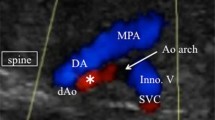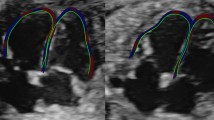Abstract
In fetal critical aortic stenosis (AS), a double reverse pattern in the pulmonary veins (PVs) is associated with a poor prognosis. We evaluated the hemodynamic changes using PV Doppler and the left atrium area/cardiac area (LA/CA) ratio in a fetus at 28 weeks of gestation with critical AS complicated with hydrops fetalis, polyhydramnios, and cardiac abnormality. A markedly enlarged LA and severe mitral regurgitation with critical AS were detected, with LA/CA ratio = 0.40 and double reverse pattern with forward/reverse velocity time integral ratio (FRVR) = 1.18 on PV Doppler. After amniotic reduction at 31 weeks, the LA/CA ratio decreased (0.24) and the FRVR in PV increased (7.11). Forward flow through the fetal aorta was seen spontaneously, and hydrops fetalis was relieved with LA volume reduction. A male neonate weighing 2171 g was delivered via cesarean section at 36 weeks with an Apgar score of 5 and 6 at 1 and 5 min, respectively. He required atrial septal opening and bilateral pulmonary artery banding after birth, followed by Norwood operation. The double reverse pattern in PVs might be reversible. The change in FRVR in PVs and LA/CA ratio would be helpful in understanding the hemodynamic change in fetal critical AS.





Similar content being viewed by others
References
Ide T, Miyoshi T, Kitao M, et al. Fetal critical aortic stenosis with natural improvement of hydrops fetalis due to spontaneous relief of severe restrictive atrial communication. J Obstet Gynaecol Res. 2015;41:1137–40.
Gardiner HM, Kovacevic A, Tulzer G, et al. Natural history of 107 cases of fetal aortic stenosis from a European multicenter retrospective study. Ultrasound Obstet Gynecol. 2016;48:373–81.
Rogers LS, Peterson AL, Gaynor JW, et al. Mitral valve dysplasia syndrome: a unique form of left-sided heart disease. J Thorac Cardiovasc Surg. 2011;142:1381–7.
Maxwell D, Allan L, Tynan MJ. Balloon dilatation of the aortic valve in the fetus: a report of two cases. Br Heart J. 1991;65:256–8.
Prosnitz AR, Drogosz M, Marshall AC, et al. Early hemodynamic changes after fetal aortic stenosis valvuloplasty predict biventricular circulation at birth. Prenat Diagn. 2018;38:286–92.
McElhinney DB, Marshall AC, Wilkins-Haug LE, et al. Predictors of technical success and postnatal biventricular outcome after in utero aortic valvuloplasty for aortic stenosis with evolving hypoplastic left heart syndrome. Circulation. 2009;120:1482–90.
Taketazu M, Barrea C, Smallhorn JF, et al. Intrauterine pulmonary venous flow and restrictive foramen ovale in fetal hypoplastic left heart syndrome. J Am Coll Cardiol. 2004;43:1902–7.
Lenz F, Chaoui R. Reference ranges for Doppler-assessed pulmonary venous blood flow velocities and pulsatility indices in normal human fetuses. Prenat Diagn. 2002;22:786–91.
Better DJ, Apfel HD, Zidere V, et al. Pattern of pulmonary venous blood flow in the hypoplastic left heart syndrome in the fetus. Heart. 1999;81:646–9.
Michelfelder E, Gomez C, Border W, et al. Predictive value of fetal pulmonary venous flow patterns in identifying the need for atrial septoplasty in the newborn with hypoplastic left ventricle. Circulation. 2005;112:2974–9.
Bower SJ. Uterine artery blood flow response to correction of amniotic fluid volume. Am J Obstet Gynecol. 1995;173:502–7.
Morine M, Maeda K, Higashino K, et al. Transient hydrops fetalis of the donor fetus in twin–twin transfusion syndrome after therapeutic amnioreduction. Ultrasound Obstet Gynecol. 2003;22:182–5.
Author information
Authors and Affiliations
Corresponding author
Ethics declarations
Conflict of interest
Sachi Sukeawa, Yuka Yamamoto, Keisuke Sato, Satomi Tanaka, Toshitaka Tanaka, and Naoki Mitsuhashi declare that they have no conflicts of interest.
Ethical statement
All procedures followed were in accordance with the ethical standards of the responsible committee on human experimentation (institutional and national) and with the Helsinki Declaration of 1964 and later versions. Informed consent was obtained from the patient for being included in the study.
About this article
Cite this article
Sukegawa, S., Yamamoto, Y., Sato, K. et al. Ultrasound evaluation of fetal critical aortic stenosis using the left atrium area/cardiac area ratio and the Doppler patterns in the pulmonary veins. J Med Ultrasonics 46, 267–272 (2019). https://doi.org/10.1007/s10396-018-0905-y
Received:
Accepted:
Published:
Issue Date:
DOI: https://doi.org/10.1007/s10396-018-0905-y




